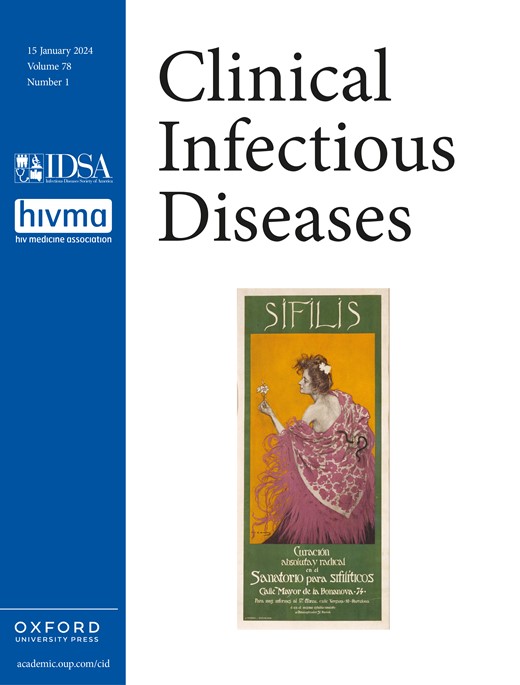Frequency of Antibiotic Overtreatment and Associated Harms in Patients Presenting With Suspected Sepsis to the Emergency Department: A Retrospective Cohort Study.
IF 8.2
1区 医学
Q1 IMMUNOLOGY
引用次数: 0
Abstract
BACKGROUND Treatment guidelines recommend rapidly treating all patients with suspected sepsis with broad-spectrum antibiotics. This may contribute to antibiotic overuse. We quantified the incidence of antibiotic overtreatment and possible antibiotic-associated harms among patients with suspected sepsis. METHODS We reviewed the medical records of 600 adults treated for suspected sepsis with anti-methicillin-resistant Staphylococcus aureus and/or antipseudomonal β-lactam antibiotics in the emergency departments of 7 hospitals, 2019-2022, to assess their post hoc likelihood of infection, whether narrower antibiotics would have sufficed in retrospect, and possible antibiotic-associated complications. We used generalized estimating equations to assess associations between likelihood of infection and hospital mortality. RESULTS Of 600 patients, 411 (68.5%) had definite (48.0%) or probable (20.5%) bacterial infection and 189 (31.5%) had possible but less likely (18.3%) or definitely no (13.2%) bacterial infection. Among patients with definite/probable bacterial infection, 325 of 411 (79.1%) received antibiotics that were overly broad in retrospect. Potential antibiotic-associated complications developed in 104 of 600 (17.3%) patients within 90 days, most commonly new infection or colonization with organisms resistant to first-line agents (48/600 [8.0%]). Mortality was higher for patients with less likely/definitely no bacterial infection versus definite/probable bacterial infections (9.0% vs 4.9%; adjusted odds ratio [aOR], 2.25 [95% confidence interval{CI}, 1.70-2.98]), but antibiotic-associated complication rates were similar (14.8% vs 18.5%; aOR, 0.79 [95% CI, .60-1.05]). CONCLUSIONS Among 600 patients treated with broad-spectrum antibiotics for possible sepsis, 1 in 3 most likely did not have a bacterial infection, 4 in 5 of those with bacterial infections were treated with regimens that were broader than necessary in retrospect, and 1 in 6 developed antibiotic-associated complications.急诊疑似脓毒症患者抗生素过度治疗频率及相关危害:一项回顾性队列研究
治疗指南建议用广谱抗生素快速治疗所有疑似脓毒症患者。这可能会导致抗生素的过度使用。我们量化了疑似败血症患者中抗生素过度治疗的发生率和可能的抗生素相关危害。方法:我们回顾了2019-2022年在7家医院急症科使用抗甲氧西林耐药金黄色葡萄球菌和/或抗假单胞菌β-内酰胺类抗生素治疗的600名疑似脓毒症患者的医疗记录,以评估其事后感染的可能性,更窄的抗生素是否足够,以及可能的抗生素相关并发症。我们使用广义估计方程来评估感染可能性与住院死亡率之间的关系。结果600例患者中,有明确(48.0%)或可能(20.5%)细菌感染的411例(68.5%),有可能(18.3%)或不太可能(13.2%)细菌感染的189例(31.5%)。在确定/可能的细菌感染患者中,411例患者中有325例(79.1%)使用过广泛的抗生素。600例患者中有104例(17.3%)在90天内出现潜在的抗生素相关并发症,最常见的是新感染或对一线药物耐药的微生物定植(48/600[8.0%])。不太可能/肯定没有细菌感染的患者死亡率高于确定/可能有细菌感染的患者(9.0% vs 4.9%;校正优势比[aOR], 2.25[95%可信区间{CI}, 1.70-2.98]),但抗生素相关并发症发生率相似(14.8% vs 18.5%;aOR为0.79 [95% CI, 0.60 -1.05])。结论:在600例接受广谱抗生素治疗的可能败血症患者中,三分之一的患者最可能没有细菌感染,五分之四的细菌感染患者接受了比回顾所需的更广泛的治疗方案,六分之一的患者出现了抗生素相关并发症。
本文章由计算机程序翻译,如有差异,请以英文原文为准。
求助全文
约1分钟内获得全文
求助全文
来源期刊

Clinical Infectious Diseases
医学-传染病学
CiteScore
25.00
自引率
2.50%
发文量
900
审稿时长
3 months
期刊介绍:
Clinical Infectious Diseases (CID) is dedicated to publishing original research, reviews, guidelines, and perspectives with the potential to reshape clinical practice, providing clinicians with valuable insights for patient care. CID comprehensively addresses the clinical presentation, diagnosis, treatment, and prevention of a wide spectrum of infectious diseases. The journal places a high priority on the assessment of current and innovative treatments, microbiology, immunology, and policies, ensuring relevance to patient care in its commitment to advancing the field of infectious diseases.
 求助内容:
求助内容: 应助结果提醒方式:
应助结果提醒方式:


